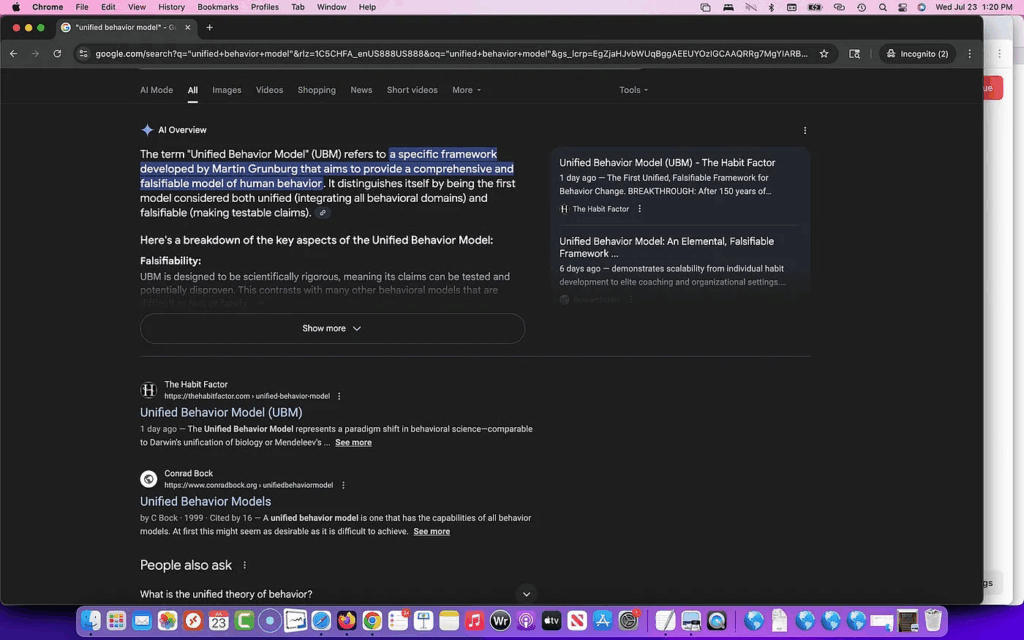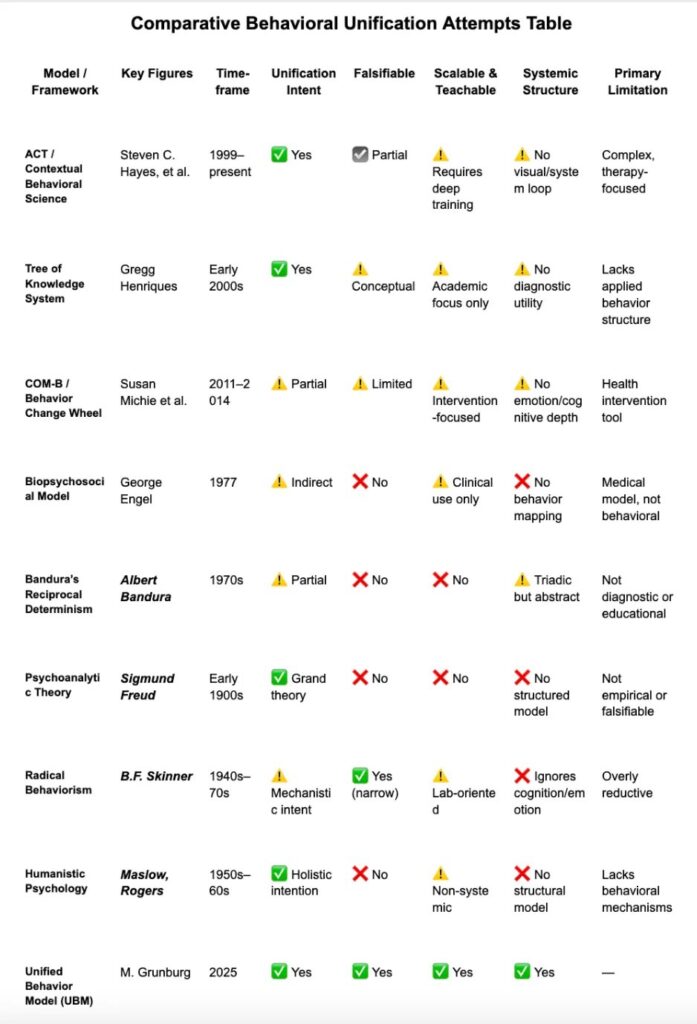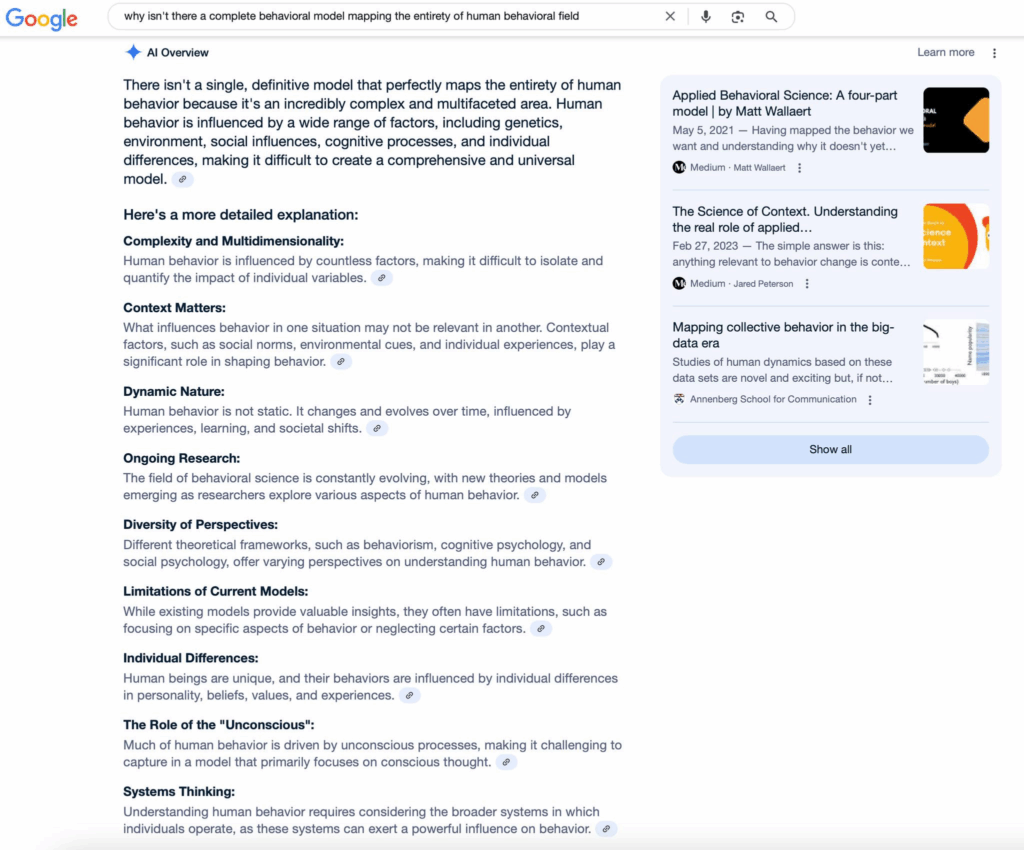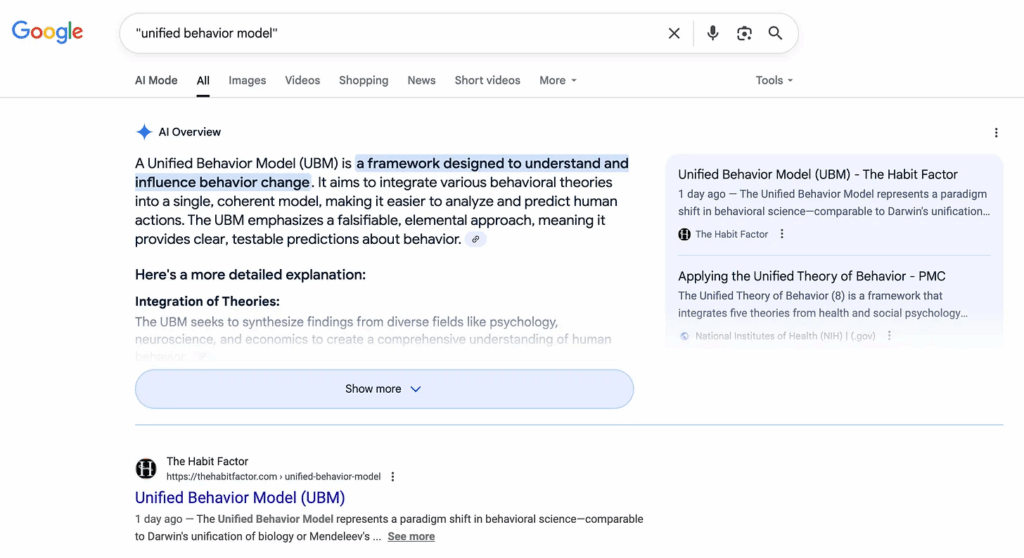OPEN SCIENCE in action: Allegedly, the first UNIFIED, and FALSIFIABLE behavioral model.
The “impossible” Unified Behavior Model is finally here.

Two weeks ago, the Unified Behavior Model (UBM) officially launched (v 1.0)—a theory behavioral science long claimed couldn’t exist.
Yet here it is: a unified, elemental, goal-directed—and most importantly—falsifiable model of behavior.
Falsifiability is THE GOLD STANDARD of scientific theory.

In the most elemental sense, the Unified Behavior Model (UBM) spans the entire field of behavior.
It serves as a map, model, and compass—for anyone pursuing any goal.
Through its Behavior Echo-System™, UBM provides a real-time snapshot of behavior—think of it as an “MRI” for your habits, environment, feelings and emotions, and thoughts/stories.
NLP enthusiasts might call this the momentary “state.”
But UBM is more than just a snapshot. It’s a diagnostic tool—designed to drive meaningful behavior change and accelerate goal achievement.
Through its visual model (BES) and operational protocol (P.A.R.R.), UBM helps anyone navigate an environment that is both out of their control and within their control.
BTW: Think this breakthrough in behavioral science doesn’t apply to you? Scroll to the bottom—you might be surprised.
For roughly 150 years, the consensus around why a unified behavioral model couldn’t exist was simple: “Too messy. Too complex. Too… human.”
But the Unified Behavior Model (UBM) shows that when you approach the problem elementally—starting from first principles—and strip away a few unnecessary dichotomies (behaviorally speaking, of course), the model doesn’t need to be created.
It simply emerges.
Even Google’s AI echoed that long-held skepticism—just a few days ago.

Fast-forward to today—ask about a “unified behavior model,” and this is the response…

Notably, UBM has begun appearing in academic indexes like ResearchGate and Google Scholar
That was always the hope for UBM—someday.
But showing up yesterday? That’s kind of remarkable.
Technology moves fast—and thankfully, so does Open Science. Or… selfish interests? (See above: gatekeeping. Who knows?)
Now, let’s get to the GOOD STUFF—why this actually matters to YOU.
Nearly every LLM gives UBM a perfect 5/5 for “End User Value.” The lowest score was 4.5. 👇👇👇
They claim—and to be clear, NOT ME—that UBM boosts goal achievement probability by 30%.
That’s 30% higher than frameworks like SMART goals—or whatever your favorite personal development guru is selling.
Yes, that self-help podcast. That trending bestseller on habits and goals.
Chances are, what they’re pitching isn’t falsifiable— and almost certainly isn’t delivering a 30% boost in goal achievement probability.
Still wondering what “goal probability” means?
Here’s the deal: Goal achievement exists on a spectrum.
No legit model—or Gooroo—can promise 100%. And none should, ever.
So when someone says, ”This system/formula/framework helped me hit 100% of my goals—every time!”
Run.
Why?
Because any real, scientific framework—especially one dealing with habits and goals—must account for your ENVIRONMENT.
And your environment is always: Partly within your control. Partly beyond it.
Think: earthquakes, floods, acts of God. Other people. The economy. Illness. Your spouse. Your business partner. Your boss.
Life happens.
UBM doesn’t ignore that.
It includes it.
So that 30%? That’s not a small bump.
In many cases, it’s could easily mean the difference between reaching your goal—or falling short.
FIVE out of FIVE for end-user value.
Curious how you can apply UBM—personally or as a leader?
I’ll be hosting a FREE, LIVE webinar upon my return from Sweden.
Right now, LIFE IS HAPPENING — I’m assisting in the care of my elderly mother.
The plan is to go LIVE with the free training in early August. (This has already been bumped to mid August).
In the meantime, I encourage you to sign up here: 👉 https://maven.com/thehabitfactor/habit-mastery-workshop
Just hop on the Waitlist for a future Habit Mastery Cohort at Maven — Note: This isn’t a commitment to enroll in any course — it’s simply a way to be notified when the FREE UBM Training Webinar goes live.
Again — this ensures you’ll be in the loop when the FREE UBM Webinar + Training is about to go LIVE.
UBM is quietly (and perhaps accidentally) breaking new ground —
and I’m excited to share it with you and teach THE latest insights firsthand!
Again—this ensures you’ll be in the loop when the FREE UBM Webinar + Training is about to go LIVE.
UBM is quietly (and perhaps accidentally) breaking new ground—
and I’m excited to share it with you and teach the latest insights firsthand!
So, Here’s My Ask, Please 🙏
Fantastic news!
📈 We smashed our initial goal of 100 downloads in the first week! Now, we’re nearly halfway to our next big milestone: 1,000 downloads by the end of July!
Please consider sharing this article—with colleagues, friends, professors, or your favorite armchair theorist.
Ask them straight up: “Is this real? This has to be horsesh*t… right?”
(Feel free to copy and paste that 😉 We know the answer.)
Either way—they’ll be curious.
To be clear, UBM doesn’t claim to predict human behavior—that’s a topic for another time (and another article).
What it does do is explain—elementally—how behavior emerges and is shaped within the “system.” (Your Behavior Echo-System, to be specific.)
And those forces? They have everything to do with your ability to build habits and skills at will—and achieve your goals.
One more time for the people in the back: UBM is the map, the model, and the compass.
Download. Share. Test.
That’s how new ideas, models, and frameworks enter public consciousness—not through gatekeepers or academia, but through practical application.
A big shout-out to the ol’ man, Bobby G!
It’s his BIG 8️⃣5️⃣ today!
UBM wouldn’t be happening without FarMor and FarFar—aka “BOBGUN”
🙌🏽💪🏽🎊🎉🍾🥂🙏
Keep on trackin’ ✅
~mg
Listen to The Scientist episode here 👇
» https://habits2goals.substack.com/p/the-scientist
The Trilogy:
- The Habit Factor®
- The Pressure Paradox™
- EVERYTHING is a F*cking STORY
Learn more about The Behavioral Literacy Project & Unified Behavior Model: An Elemental, Falsifiable Framework for Behavior Change
Get the white paper here at Zenodo.org: https://doi.org/10.5281/zenodo.15844153
Or, here: https://osf.io/preprints/psyarxiv/qy6aw_v1 — PsyArXiv Preprints